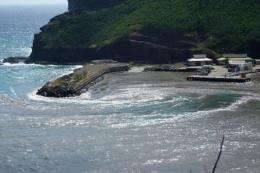A wave hits the coast of the Hakahau city in the French Polynesia Marquesas Ua Pou island. A tsunami triggered by the powerful quake that rocked Chile was Saturday racing across the Pacific Ocean towards Hawaii and Asia at around 450 miles per hour, a quake expert said.
A tsunami triggered by the powerful quake that rocked Chile was Saturday racing across the Pacific Ocean towards Hawaii and Asia at around 450 miles per hour, a quake expert said.
Estimating the depth of the wave's water column to be around four kilometers (2.4 miles) on average, Roger Bilham, a professor of geological sciences at the University of Colorado, calculated that at mid-ocean, the mass of water would be hurtling toward Hawaii at 200 meters per second, or 720 kilometers per hour (446 mph).
"Mid-ocean, the wave is traveling at around the speed of a jet plane," Bilham told AFP.
"The amplitude of the wave is small when it's mid-ocean, but it may rise to five to 10 meters when it reaches Japan or the Philippines," he said.
A huge arc of nations around the Pacific, from New Zealand to Japan, have gone on tsunami alert, while sirens sounded warnings of destructive waves around Hawaii for the first time in 16 years.
The powerful 8.8-magnitude quake that rattled Chile in the early hours of Saturday occurred offshore in a subduction zone -- the point where two tectonic plates meet and one plunges beneath the other.
The undersea earthquake that set off the 2004 Asian tsunami, which killed some 200,000 people and left hundreds of thousands homeless, was also a subduction earthquake.
"Subduction zone earthquakes produce the world largest tsunamis because the sea floor moves like a piston, heaving 100 kilometer by 50 kilometer (60 miles x 30 miles) or larger regions of sea floor water up or down," Bilham told AFP.
Walls of water of up to four meters (13 feet) crashed ashore in French Polynesia and the Marquesas Islands hours after the quake had rattled Chile.
But the tsunamis caused only minor damage and no casualties as they rampaged across the Pacific, where authorities had sounded warning sirens and urged residents of coastal areas to move to higher ground.
The tidal waves that devastated parts of southern Asia in 2004 struck without warning. It was after that deadly series of monster waves that the Pacific Tsunami Warning Center, set up after a tsunami unleashed by a 9.5-magnitude earthquake in Chile in 1960, beefed up its warning system.
"This time, we're ready for the tsunamis. When the waves hit Hawaii, there will be cameras there to catch them," said Bilham.
"This is a huge success," he said.
(c) 2010 AFP



















